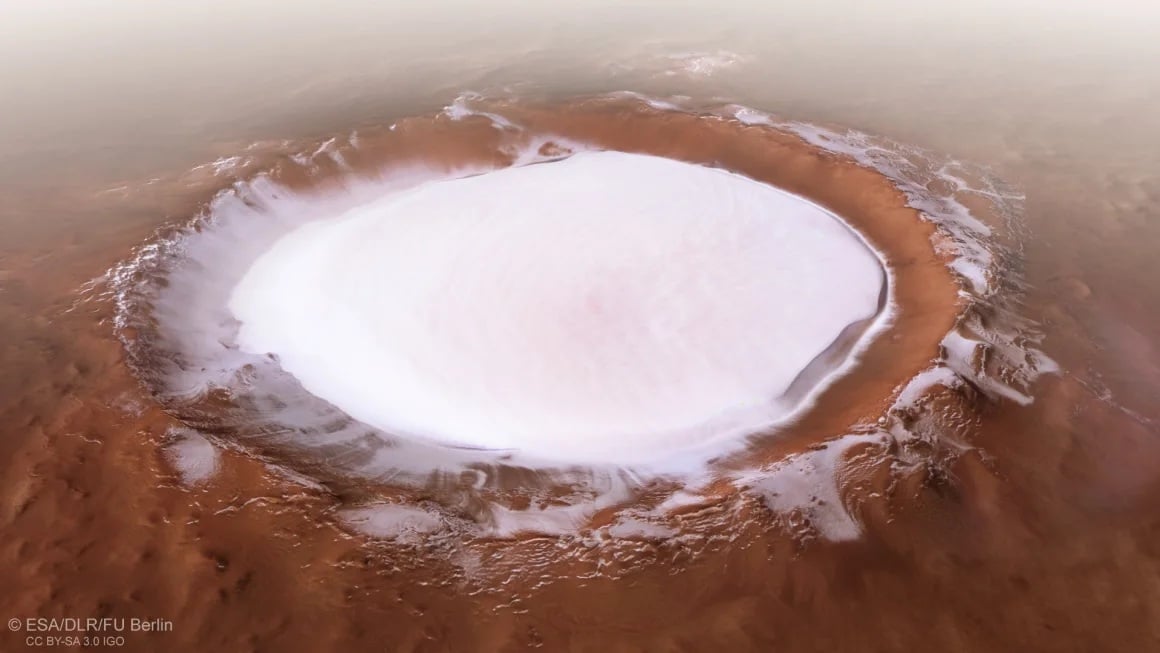Science
Ice Deposits in Martian Craters Reveal Planet’s Climatic History

Recent research has uncovered that ice deposits within Martian craters provide critical insights into the planet’s climatic history. These deposits suggest that Mars was once a warmer and wetter place, featuring rivers, lakes, and possibly even a vast ocean in its northern hemisphere. Over the past five decades, scientists have studied various geological features on Mars, raising essential questions about the planet’s water history and the processes that transformed it into the cold, arid landscape we see today.
A team of researchers from Japan led by Trishit Ruj, an associate professor at Okayama University, has published findings in the journal Geology. Their study indicates that craters on Mars are not only repositories of ice but also serve as historical records of the planet’s climatic shifts. They found that Mars experienced multiple ice ages over hundreds of millions of years. Notably, the amount of ice has steadily declined, reflecting a significant loss of water throughout its history.
The research team included experts from Kochi University, the International Research School of Planetary Sciences, Brown University, the University of Tokyo, and the JAXA Institute of Space and Astronautical Science. They focused their analysis on glacial landforms in craters located between 20°N and 45°N latitude, utilizing high-resolution images from NASA’s Mars Reconnaissance Orbiter.
Ice Layers and Climate Shifts
The researchers concentrated on craters exhibiting signs of glaciation, such as ridges and debris left by ice sheets. They discovered that ice deposits consistently formed in the shadowed southwestern walls of these craters. This pattern persisted throughout multiple glacial periods during the Amazonian period, which spans from approximately 640 to 98 million years ago.
Dr. Ruj noted in a press release from Okayama University, “Like Earth, these shifts in Mars’ climate were caused by changes in the planet’s axial tilt (obliquity), which is about 25 degrees, similar to Earth’s 23.4-degree tilt.” Unlike Earth, however, Mars experiences dramatic variations in obliquity over geological timescales, leading to cycles of glaciation and thawing that gradually reduced the planet’s ice reserves.
These findings indicate that Mars has gradually dried out over the course of the Amazonian Era, marking the longest geological period in its history. The implications of this research extend beyond our understanding of Mars. The data could guide future crewed missions aimed at utilizing local water ice for essential needs such as food production, oxygen generation, and fuel.
Implications for Earth and Mars Exploration
Given the lengthy journey between Earth and Mars—taking six to nine months one way with conventional propulsion—in-situ resource utilization (ISRU) will be essential for sustaining human life on Mars. The research team believes their findings could also help address challenges posed by climate change on Earth.
As global temperatures rise, the planet faces increased drought, forest fires, and flooding, resulting in a strain on fresh water supplies. The imaging and modeling techniques developed for studying Martian ice deposits could assist scientists in monitoring terrestrial glaciers and hidden water reserves.
Dr. Hasegawa from Kochi University emphasized the value of Mars as a natural laboratory. He stated, “The insights we gain here can sharpen our understanding of climate processes on Earth as well.” By studying the ancient climate of Mars, researchers can better understand the dynamics affecting our own planet’s environment.
This research not only enriches our knowledge of Martian history but also highlights the interconnectedness of planetary sciences, offering lessons that may be crucial for addressing future environmental challenges on Earth.
-

 Business4 days ago
Business4 days agoInvestors Eye Potential $60,000 Gains with Ozak AI Token
-

 Politics5 days ago
Politics5 days agoFormer Pastor Arrested on Human Trafficking and Indecent Charges
-

 Business5 days ago
Business5 days agoQuotient Wealth Partners Adjusts Holdings in iShares Russell 1000 ETF
-

 Lifestyle5 days ago
Lifestyle5 days agoNatty from KISS OF LIFE Stuns in Micro-Shorts at Seoul Event
-

 Politics4 days ago
Politics4 days agoSkip Bayless Critiques Travis Hunter’s Game Day Baptism
-

 Entertainment5 days ago
Entertainment5 days agoUtah Residents Face Resource Shortages Amid Ongoing Government Shutdown
-

 Business5 days ago
Business5 days agoCalifornia to Ban All Plastic Bags in Grocery Stores by 2026
-

 Entertainment5 days ago
Entertainment5 days agoPete Davidson Surprises Pregnant Girlfriend with Private Jet to Concert
-

 Politics5 days ago
Politics5 days agoIberia Parish Sees Surge in Marriage Licenses Issued in October
-

 Entertainment5 days ago
Entertainment5 days agoAce Frehley, KISS Guitarist, Passes Away at 74 After Fall
-

 Science5 days ago
Science5 days agoCommunity Mourns Loss of Judith Ernst, Pioneer Educator at 81
-

 Entertainment6 days ago
Entertainment6 days agoEastside Kings Festival Celebrates Austin’s Rich Blues and Jazz Heritage









